The Living Organisms: Characteristics And Habitats
Living organisms can be found everywhere on the Earth including extremely hot deserts, cold mountains, deep oceans, and even in the openings of volcanoes. All these places are so different from each other, yet all of them have living organisms of various kinds.
In the mountains of the Himalayas, where it is very cold, many kinds of trees like oaks, pines, and deodars are found.
Similarly, hot desert areas, like Rajasthan, have different kinds of cactus plants and seashore areas like Puri have an abundance of Casuarina trees. Like plants, different kinds of animals are also found in different areas.

Organisms And The Surroundings Where They Live
The kinds of plants and animals found in one region are very different from the plants and animals of the other regions. Some of the examples are listed below.
Read and Learn More Class 6 Science Notes
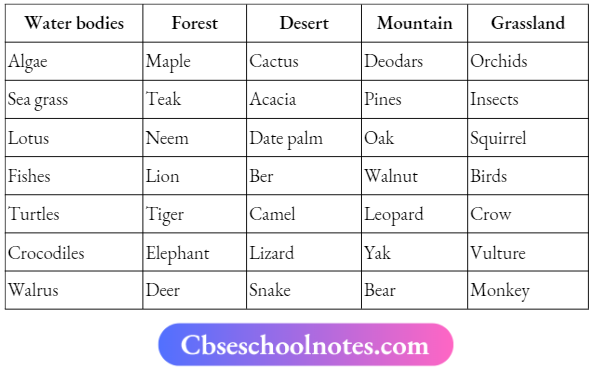

Adaptation
Adaptation is the presence of specific features or certain habits that enable a plant or an animal to live in its surroundings naturally. Different animals are adapted to their surroundings in various ways.
For example, the sea and the desert are very different surroundings, and different kinds of plants and animals are found in these two regions. Let us take examples of caramel (from the desert) and fish (from the sea) to understand it better.
1. Adaptations in Camel
The features of a camel, that help it survive in desert conditions are listed below
- Camels have long legs which help to keep their bodies away from the heat of the sand.
- They excrete a small amount of urine and their dung is dry. They do not sweat. Since they lose very little water from their bodies, camels can live for many days without water.
- Padded feet help camel to walk on hot and slippery sand without sinking.
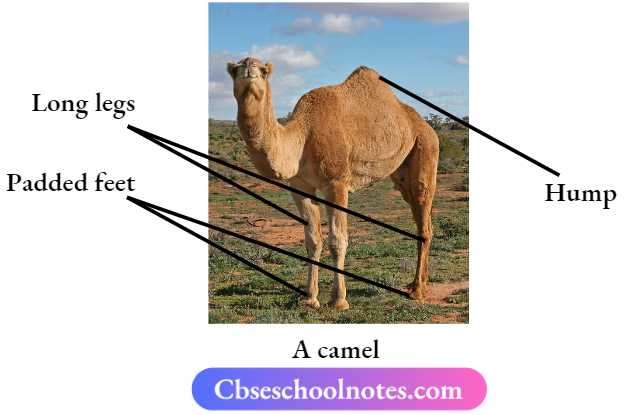
2. Adaptations in Fish
The features of a fish which enable it to live in freshwater sea are listed below
- They have streamlined shapes. This shape helps them to move inside water.
- They have slippery scales on their bodies. These scales protect the fish and also help in easy movement through water.
- They have flat fins and tails that help them to change directions and keep their body balanced in water.
- Gills present in the fish help them to use oxygen dissolved in water.

Acclimatization
It can be defined as the process where an organism adjusts its behavior or physiology in response to changes in its environment (i.e. altitude, temperature, etc.).
For instance, if we live in the plains and suddenly go to high mountain regions we may experience difficulty in breathing, nausea, headache, etc. This happens because the air supply is reduced at high altitudes.
However, after a few days, our body adapts to this change. This is called the acclimatization of the body to the environment. These changes are different from adaptations that take place over thousands of years.
Habitat
The place where an organism lives, grows, and interacts with other organisms is called habitat. It provides the living organism with food, shelter and favorable climatic conditions to survive, breed, and flourish.
Several kinds of plants and animals may share the same habitat. Living beings live on land, in water, or on trees.
Types of Habitat
Habitat is broadly divided into two types, i.e. terrestrial and aquatic.
- Terrestrial Habitats The plants and animals that live on land are said to live in terrestrial habitats, for Example forests, grasslands, deserts, and coastal and mountain regions.
- Aquatic Habitats The habitats of plants and animals that live in water are called aquatic habitats, for Example ponds, swamps, lakes, rivers, and oceans.
There are large variations among terrestrial habitats like forests, grasslands, deserts, and coastal and mountain regions located in different parts ofthe world. Similar variations are observed for all aquatic habitats.
Components of a Habitat
- Habitat consists of living organisms interacting with the environment. It has two basic components.
- Abiotic Components These include non-living components, for example. air, water, soil, sunlight, rocks, etc.
- Biotic Components These include living organisms, Exampele plants and animals.
Components of a Habitat
Habitat consists of living organisms interacting with the environment. It has two basic components.
- Abiotic Components These include non-living components, for example, air, water, soil, sunlight, rocks, etc.
- Biotic Components These include living organisms, for Example plants and animals.
Some Terrestrial Habitats
The organisms that live on land are said to live in terrestrial habitats. Some of them are as follows
Deserts
These habitats include vast areas of land with sand and little or no vegetation. They also get very little rain. These are hot and dry places. Organisms that live here have to cope with these adverse climatic conditions, so they develop adaptations accordingly.
Adaptations in Plants
The desert plants have the following adaptations that help them to survive in hot and dry conditions.
- Leaves are either absent or are very small and spiny to reduce water loss through transpiration.
- The leaf-like structure in a cactus is its stem. Photosynthesis in these plants is usually carried out by the stem. The stem is also covered with a thick waxy layer which helps to retain water.
- Also, plant roots are very deep for absorbing water from larger areas, for example, Acacia, ber, etc.

Adaptations in Animals
The desert animals have the following adaptations that help them to survive in hot and dry conditions.
- There are desert animals like rats and snakes, which stay in burrows deep in the sand during the daytime to stay away from the intense heat.
- These animals come out only during the night when it is cooler.
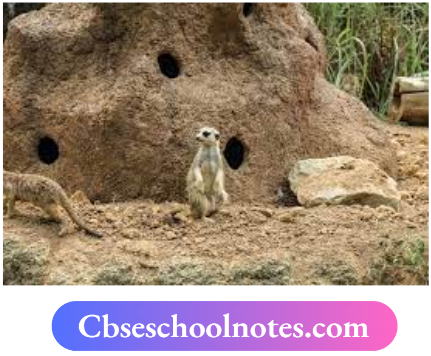
Science Insight Some animals show behavioral adaptation, A Cape ground squirrel uses a long bushy tail as a parasol or an umbrella. It provides shade in the scorching heat of the Sun.
Mountain Regions
These areas are generally very cold and windy. Some mountains may receive snowfall during winter. As we go up in the mountainous regions, the surroundings change and we see different kinds of adaptations at different heights.
The plants and animals inhabiting these regi show special kinds of adaptations as given below
Adaptations in Plants
There are following features present in plants that help them to survive in mountain regions are
- The trees are usually cone-shaped with tilted branches which helps rainwater and snow to slide off easily.
- They have thick bark to protect them against the severe cold.
- These plants bear needle-shaped leaves, thus reducing water loss.
Adaptations in Animals
The animals living in the mountain regions have the following adaptations
- The yak has thick skin or fur to protect them from cold.
- The snow leopard has thick on its body including toes and feet This protects its feet from the cold when it walks on the snow.
- The mountain goat has long hair to keep it warm and strong hooves for running up the rocky slopes of the mountains.
Science Insight Animals like hedgehogs and dormouse hibernate (deep sleep) throughout the winter to save energy and survive the winter without eating much. They utilize the stored food (as fat) in their bodies.
Grasslands
- These habitats include short and tall grasses scattered with small and large trees. Such habitats have hot summers and chilly winters.
- Lions and deer have different types of adaptations to survive in the same habitat.
Lion
It is a strong animal that can hunt and kill animals like deer. The adaptations which enable lions to survive in a forest or a grassland are as follows.
- It is a light brown which helps it to hide in dry grasslands when it hunts for prey (animals to eat).
- It has long claws in its front legs that can be withdrawn inside the toes.
- The eyes in front of the face allow it to have a correct idea about the location of its prey
Deer
It is another animal that lives in forests and grasslands. The following features help it to survive in this habitat.
- It has strong teeth for chewing hard plant stems in the forest.
- A deer needs to know about the presence of predators (animals that feed on other animals, like lions) to run away from them and not become their prey so, it has long ears to hear the movements of predators.
- The eyes on the sides of its head allow it to look in all directions for danger.
- The speed of the deer helps it to run away from the predators.
Some Aquatic Habitats
The organisms that live in water are said to live in aquatic habitats. These are further subdivided into marine and freshwater habitats.
Oceans
Oceans and seas are marine water habitats. The animals living in the ocean show a variety of shapes and structures. Some examples are given below.
- Many sea animals have streamlined bodies to help them move easily in water, Example fishes.
- Octopuses and squids do not have this type of body. They stay in the deeper layer of the ocean, near the seabed, and catch any prey that moves towards them. However, while moving in water, they can streamline their bodies.
- These animals have gills to breathe and use the oxygen dissolved in water.
- Whales and dolphins do not have gills. They breathe in air through nostrils or blowholes. These are located at the upper part of their heads.
- This allows them to breathe In air when they swim to the surface of the water. They can stay inside the water for a long time without breathing. They come out to the surface from time to time, to breathe in air.
Ponds and Lakes
- The ponds, lakes, and rivers are freshwater aquatic habitats.
- The plants which grow in water are called aquatic plants.
- All aquatic plants have the following aquatic adaptations
- Their roots are either small or not very well developed with the primary function of anchorage.
- Their leaves are ribbon-like and long to cope with the water currents.
- Stems of these plants are long, hollow, and light with spaces filled with air to keep them floating.
- The plant body is covered with mucilage which prevents decay in the water.
There are three types of aquatic plant
- Free-Floating These aquatic plants float on water. Their roots are very small and they freely float on the surface of the water, for example, water hyacinths.
- Partly Submerged These aquatic plants are fixed in the soil at the bottom by their roots. The stem of these plants grows up to the surface of the waterbody, and leaves and flowers float on the surface of the water, for example, lily and lotus.
- Completely Submerged All the parts of such plants like stems, branches, and leaves are underwater. These plants are also fixed to the soil at the bottom by their roots example hydrilla.

Adaptations In Frog
They usually have ponds as their habitat. Frogs can stay both inside the pond water as well as move on land. They have strong back legs that help them in leaping and catching their prey. They have webbed feet which help them swim in water.
Characteristics Of Living Organisms
A large variety of materials or things are present around us. Some of them are living while others are non-living. Living organisms can be identified based on the following features.
- They need food, water, and air to survive.
- They can grow.
- They can move on their own.
- They respond to stimuli.
- They reproduce themselves.
- They respire and release energy from food.
- They excrete and get rid of waste materials from their body.
- They have a definite lifespan.
- They are made up of living cells.
- Non-living things do not perform any of the above functions.
Let us discuss a few important characteristics of living beings in detail
1. Food
- AH living beings including plants and animals need food to stay alive. Food gives organisms the energy needed to grow. Organisms also need this energy for the life processes that go on inside them.
- Along with food they also need air and water. Plants make their food with the help of sunlight, air, and water, through the process known as photosynthesis. Whereas animals and humans depend on plants other animals and their products for their survival.
2. Growth
All living things (plants and animals) show growth by increase in size and weight. When living things grow, they become taller and bigger on their own. For example,
- A baby grows into an adult.
- A small puppy grows and becomes a dog.
- A chicken hatched from an egg grows and becomes a hen or a cock.
- Similarly, a small plant grows and becomes a big tree.
3. Respiration
- It is a vital process carried out by all living organisms. It is through respiration that the body finally obtains energy from the food it takes.
- When we inhale, the air moves from the outside to the inside of the body. When we breathe out we expel the air which is inhaled.
- Breathing is a part of respiration. All living organisms breathe in oxygen, which is used by the living body and gives out carbon dioxide produced in the process. The mechanism for the exchange of gases is different in different organisms.
Some examples are given below
- Earthworm breathes through its skin.
- Fishes use gills to obtain dissolved oxygen from water.
- Insects have tiny pores on their exoskeleton (body wall).
- Plants also respire through tiny pores present on their leaves called stomata.
In sunlight, plants use carbon dioxide in the air to produce their food and give out oxygen. Plants produce their food only during the daytime, whereas respiration in them takes place day and night.
The amount of oxygen released in the process of food preparation by plants is much more than the oxygen they use in respiration.
4. Response to Stimuli
All living things respond to changes around them. The changes in our surroundings that make us respond to them are called stimuli. A few examples are given below
- Wild animals run away when a bright light is flashed on them.
- Cockroaches begin to move to their hiding places if the light in the kitchen is switched on at night.
- We close our eyes when a sudden bright light is flashed or when we suddenly move from a dark place to bright sunlight.
- In some plants like Mimosa, commonly known as ‘touch-me-not’ leaves close or fold when someone touches them. Flowers of some plants bloom only at night whereas in some plants flowers close after sunset.
5. Excretion
The process of removal of waste from the body is called excretion.
All living things take food, but not all food that is eaten is used. A part of it that is not used is removed as a waste.
Our body also produces waste products in life processes like respiration, digestion, etc. These waste products are harmful to our body which is why these products have to be removed from our body. Thus, it becomes a necessary process carried out by all living organisms.
Plants also Excrete
The mechanisms of excretion in plants are a little different. Some harmful or poisonous materials are produced in plants as waste.
Some plants find it possible to store the waste products within their parts in a way that they do not harm the plant as a whole.
They shift waste products towards the outermost layer of the stem, making it harder and stronger. Some plants remove waste products as secretions, For Example, gum and resins are excretory products of the plant.
Science Insight The excretory products of plants are used in many ways. For example, resins are used to make paints and varnishes, gums are used to treat wounds, and serve as an important ingredient in adhesives
6. Reproduction
It is the process by which living things produce more of their kind. This is true for both animals and plants.
Reproduction takes place in many different ways in different organisms. Some modes of reproduction are given below
- Animals like insects, fishes, and birds lay eggs and when these eggs hatch, the young ones come out and grow into adults,
- Some animals like cats, dogs, cows, and human beings give birth to young ones.
- Plants also reproduce. Many plants produce seeds which can germinate and grow into new plants.
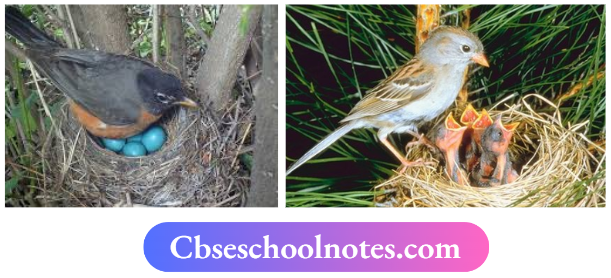
Some plants reproduce through parts other than seeds, Example a part of a potato with a bud, grows into a new plant. They also reproduce through cutting.

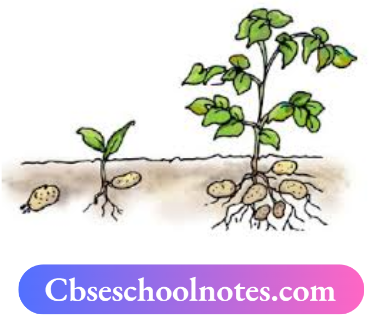
7. Movement
It is one of the most important signs of life in an organism. All living things move by themselves. Animals can from one place to another.
Plants are generally anchored in soil so they do not move from one place to another. However, various substances like water, minerals, and the food synthesized by them move from one part of the plant to another. Also, opening and closing off lower is a movement.
Death
It is another common characteristic of living beings simple. It marks the ending oflife and reproduction is the starting oflife. Reproduction ensures the continuity of particular organisms.
A particular type of organism can survive over thousands of years only if it reproduces its kind. One single organism may die without ever reproducing, but that type of organism can exist only if there is reproduction.
Some Exceptions of Living Organisms
We can conclude that living things may have all the characteristics that we have discussed, while non-living things may not show all these characteristics at the same time.
- Non-living things like cars, bicycles, clocks, and water in the river move. The Moon moves in the sky, and a cloud grows in size.
- Sometimes living things may also not show all the characteristics of the living. For example, seeds stay in a shop for months and do not show any growth or some of the other characteristics of life. However, we bring the same seed and plant it in soil, water it and it turns into a whole plant.
Activity 1
Aim: To show the effect of abiotic factors on the germination of seeds to form young plants.
Materials Required: Dry moorig seeds, water, 5-6 containers, refrigerator.
Procedure:
- Collect some dry moong seeds.
- Keep 20-30 seeds aside and soak the rest in water for a day.
- Divide the soaked seeds into four parts, i.e. (Parts A to D).
- Part A = Completely submerged in water for 3-4 days.
- Part B = In a sunny room
- Part C = In a cupboard that does not allow any light to come in.
- Part D = In the refrigerator.
4. Let the setup remain undisturbed and observe after a few days.
Observation: After a few days following observations are made
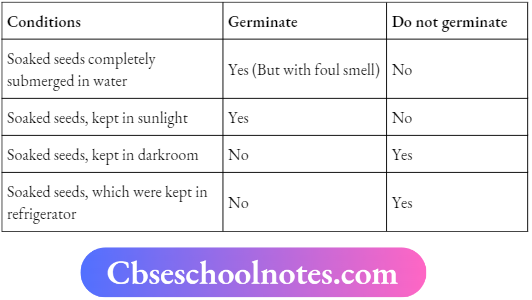
Conclusion: We conclude that sunlight, air, water, and proper temperature are necessary for the germination of seeds.
Activity 2
Aim: To show that a desert plant loses very little water through transpiration.
Materials Required: One potted leafy plant, one potted cactus plant, two transparent polythene bags, thread.
Procedure:
- Take two potted plants, one leafy and another cactus.
- Tie separate polybags to both plants and keep them in sunlight.
- After a few hours observe the inner surface of polybags.
Observation: We will observe that there are more water droplets in the leafy plant as compared to the cactus plant.
Conclusion: The rate of transpiration (loss of water through leaves) in cactus, is much lower as compared to the leafy plant. This is because of the adaptation acquired by cacti to survive in hot and dry places.
Activity 3
Aim: To show that sunlight acts as a stimulus for plants.
Materials Required: A potted plant, water,
Procedure:
- Place a potted plant in a dark room near a window through which sunlight enters the room as shown in the figure.
- Water the plant regularly and observe it for a few days. Observation We will observe that the growth of the plant occurs towards the window from where the plant gets sunlight.
Conclusion: Plants tend to grow toward sunlight so, that they can avail it and carry out photosynthesis. Thus, sunlight serves as a stimulus for plants.

